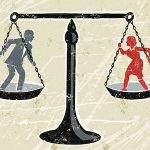This year the so-called “Equal Pay Day” was April 12th. It’s “celebration” is a weak attempt at capitalizing on the notoriety of the entirely valid “Tax Freedom Day” (i.e. the day after which a country’s citizens get to keep all their income if they were theoretically taxed at 100% until their tax burden was satisfied). In 1900 in the United States Tax Freedom Day was January 22. Today it is April 24. We have lost a lot of freedom in the interim. Many real injuries to women’s right have been reversed in that same interim; however pay inequality has always been a phantom menace. Equal Pay Day is but a disingenuous mischaracterization of a statistical truth as proof of willful malfeasance.
Yes, if you lump all female workers together and all male workers together the females earn about 79% of what the men earn. But through willful blindness of the trees (different jobs) in observation of only the forest (aggregate salaries) this statistic fails to make the case that it is employer discrimination that robs women of their rightful earnings. To highlight this failing consider another similar statistics. Comparing workers below age 45 against those over age 45 we find a similar gap. Those 45 and under earn about 80% of those 45 and over. Clearly there must be a bias toward paying older works more. Or consider not pay but rather work place fatalities. On average, for every female workplace fatality there are twelve men who perish. Again, clearly this must be a sign of a negligent disregard for the safety of men in the workplace relative to women. Oh, what’s that you say? There are obvious reasons why an older worker would earn, on average, more than a younger worker? There are obvious reasons why more men would die in the workplace than women? True (to both), yet somehow the “obvious” reasons that would also contribute to a difference in aggregate pay between men and women are dismissed out of hand whenever issues of gender pay disparity are discussed. Why is that?
If one were to look at wages at a hypothetical hospital where all the men were doctors and all the women were nurses would it not be surprising that the women made less than the men in aggregate? In reality, when numbers are adjusted for age and education, women (pre-child birth) earn just as much if not more than men in several fields. The shift occurs as couples start to have children and women take on the traditional role of staying at home and raising children. This means they leave the workforce (reducing earnings based experience) or take on lower paying, more time-flexible positions.
Now the strident feminists among us might actually agree and say it is this cultural “patriarchy” that must be changed – by force. I’m not sure what they would have us do though – have the government decide which parent must raise the children in order to keep the distribution of male/female stay-at-homers equal across society? Even though feminists may privately admit that culture is the real reason for this wage “gap”, publicly they persist in casting employers as the scapegoat. This stance though demonstrates a profound lack of understanding of basic economics. Unsurprisingly, the type of person who will loudly clamor for more government intervention in the workplace to ensure “fair” pay for women will also decry the “greed” of the employer in paying them less. The irony of that position is that if the wage gap were employer driven, their supposed vice (greed) would quickly neutralize it. A properly “greedy” employer would seek out every women they can find in order to achieve a 20% discount on their payroll. In turn the unemployment rate for women would be 0%. But of course it is not. This lack of 0% female (or any supposedly discriminated group for that matter) unemployment should put to rest the notion that discrimination is the proximate cause for such pseudo-pay disparities.
